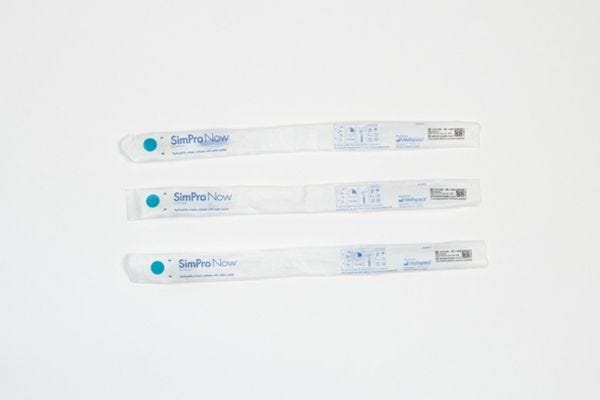When you first begin using an intermittent catheter, it’s expected that you'll feel some level of discomfort, but you should never feel pain when self-catheterizing!
Pain during this process isn’t normal and can cause harm to your urethra and discourage you from using intermittent catheters.
If you do feel pain during self-catheterization, use this article to learn the causes behind it and how to avoid it so you can catheterize with ease.
We’ll also tell you how to get your urinary catheters covered by insurance so you can stop paying out of pocket for necessary medical supplies.
What Causes Pain When Using Intermittent Catheters?
It’s normal to feel slight discomfort when first using intermittent catheters for a few reasons.
- You’re self-catheterizing incorrectly. The self-catheterization process can seem complicated at first, and you may need to practice before you get it right, especially if you’ve never done it before. However, it does become easier the more you catheterize.
- You need a different intermittent catheter. Generally, your healthcare provider will recommend which style, material, and length of intermittent catheter you should be using.
Check Your Eligibility
2 Easy Steps
Discover the catheter supplies covered by your insurance.
You may need to adjust which catheter you're using if your anatomy changes or if you’re experiencing issues with your current intermittent catheter.
If you’re experiencing discomfort that lasts or turns into uncomfortable pain, you should speak with your healthcare provider right away to determine the cause
Continued Pain May Occur Because You...
- Are self-catheterizing improperly. You may be using too much force or be too tense during the process.
- Are using the wrong type of lubrication. Certain catheters use lubrication packets or specified lubrication types.
- Have urethritis. This inflammation of the urethra occurs when you are inserting your catheter incorrectly or not using enough lubrication.
- Are not catheterizing frequently enough. It’s recommended that you self-catheterize when you feel your bladder is full, or around 4-6 times a day, to empty urine from the bladder. Not doing so could lead to urinary tract infections (UTIs) due to a build-up of bacteria.
- Have a UTI or a catheter-associated urinary tract infection (CAUTI), both of which cause pain while self-catheterizing.
- Have a urethral stricture. This scar tissue forms in your urethra when you’ve damaged it.
- Created a false passage. These are created when forceful self-catheterization occurs or if you have an enlarged prostate, among other things.
Seek the help of a healthcare professional if you experience any of the following symptoms while using intermittent catheters, as they may indicate the above issues.
- Urethral pain upon catheter insertion or removal.
- Leaking urine.
- Bleeding
- Pain when urinating.
- Urine not draining from the catheter.


How to Get Catheter Care Products Through Insurance
A report conducted in 2022 estimated that the average catheter user pays around $790 out of pocket every year for catheter supplies!
At Aeroflow Urology, we know products necessary to maintaining your quality of life shouldn’t cost you, which is why we supply those who qualify with intermittent catheters through insurance.
To qualify, you’ll need:
- A prescription for an intermittent catheter.
- Insurance coverage.
While your coverage will vary based on your specific insurance plan, we currently work with:
- Medicare plans.
- Medicare Advantage plans.
- Commercial plans, such as Humana, BCBS, Aetna, United Healthcare, etc.
- Medicaid plans.


You may also need to meet other requirements based on your insurance plan.
Fill out our easy Eligibility Form to find out if you qualify!
Once you submit the form, we don’t share your information with anyone, and one of our experts will reach out within days to let you know if you’re eligible for coverage. We’ll also:
- Give you free intermittent catheter samples so you can determine which product is right for you.
- Ship your intermittent catheter products straight to your door for free.
Real Reviews From Our Catheter Users
“Very polite, considerate, and helpful in obtaining my catheter supplies. Understanding and sympathetic to the emotional aspects of having to start self-catheterization.”
-Dorothy F.


“I was confused about different catheters, but on several calls, they told me practical stuff that my doctor didn't bother to. Really great service, too. This is a trustworthy company which is one thing my doctor got really straight.”
-David K.


7 Tips for Pain-Free Self-Catheterization
Experiencing pain when self-catheterizing is not normal! Use these tips for pain-free self-catheterization and seek medical advice if catheterization is causing you pain.
1. Use the Right Intermittent Catheter
While you may need to adjust your intermittent catheter size, length, or tip type if issues occur or your anatomy changes, your healthcare provider will typically recommend the right type for you. They’ll determine:
- French size: The French size is the diameter of the intermittent catheter. Typically, males will use a french size 14, and females will use 12.
- Length: This will be largely dictated by your gender; Males usually use a longer length and females use shorter lengths. There are situations where a female might prefer to use a male-length catheter due to needing more catheter to grip, but in either case, your provider will recommend which length is best suited for you.
- Tip type: Based on your conditions and anatomical needs, your provider will suggest which type of intermittent catheter tip you should use.
-
- Coude tip: A curved tip that allows for easier insertion. These are best suited for you if you have urethral strictures, an enlarged prostate, or any other condition that makes insertion with a straight-tip catheter more difficult.
- Straight tip: A straight tip from top to bottom.
- Material: Your provider will recommend a non-latex catheter tube, such as a silicone or vinyl tube if you have a latex allergy.


You should never use a latex intermittent catheter if you have a latex allergy as it could result in hospitalization.
2. Practice Proper Catheterization
Improper catheterization can result in issues such as:
- Urethritis.
- Urethral strictures.
- False passages.
- General pain.
You should never force your intermittent catheter into your body, and if something doesn’t feel right, take your catheter out, and try again.
Use our downloadable self-catheterization guides for males, females, and children for a step-by-step guide on safe urinary catheterization.
3. Relax Your Body
When first beginning to self-catheterize, you may be nervous, which can cause your body to tense up. Tense muscles make insertion more difficult. Take a few deep breaths to ease your mind and calm your body before inserting your intermittent catheter. Upon insertion, go slowly so as to not damage your urethra.
4. Position Yourself Correctly
It’s important that your body is not only relaxed but also in the correct position to self-catheterize.
- Males: Stand in front of or sit on the toilet.
- Females: Sit on the toilet with thighs spread apart or stand with one leg on the toilet.
5. Use Catheters With Polished Eyelets
Eyelets are holes on the insertion tip which is how urine drains into your catheter tube. Look for eyelets that are polished rather than regular eyelets, as these can be rough and cause irritation. Aeroflow Urology offers a variety of intermittent catheters with comfortable polished eyelets for smooth catheterization.
6. Use the Correct Lubrication
Some intermittent catheters may require you to lubricate them before insertion. It’s critical to your comfort that you use the right type of lubrication. You should not use petroleum jelly or any other non-approved lubricant. You can get lubrication packets or your catheter may come with packets. Another option is to use hydrophilic or pre-lubricated intermittent catheters.
7. See Your Healthcare Provider
If you’re experiencing any pain during self-catheterization, you should see your healthcare provider to determine what the cause is.
National Study Finds Limited Health Plan Coverage and High Out-of-Pocket Costs for Catheter Users. (n.d.). Spina Bifida Association. Retrieved November 22, 2022, from https://www.spinabifidaassociation.org/news/national-study-finds-limited-health-plan-coverage-and-high-out-of-pocket-costs-for-catheter-users/
Information provided on the Aeroflow Urology website is not intended as a substitute for medical advice or care from a healthcare professional. Aeroflow recommends consulting your healthcare provider if you are experiencing medical issues relating to incontinence.









